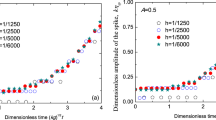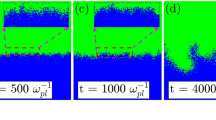Abstract
INTEREST has recently been shown in Rayleigh-Taylor instabilities such as might affect the flow of a striated fluid in a magnetohydrodynamic-generator duct. In such situations there will be an electromagnetic force of value J × B, where J is the electric-current density and B is the magnetic-field strength, in addition to forces due to gravity and acceleration of the fluid.
This is a preview of subscription content, access via your institution
Access options
Subscribe to this journal
Receive 51 print issues and online access
$199.00 per year
only $3.90 per issue
Buy this article
- Purchase on Springer Link
- Instant access to full article PDF
Prices may be subject to local taxes which are calculated during checkout
Similar content being viewed by others
References
Lemaire, A., Commissariat a l'Energie Atomique. Groupe d'Etudes de Magneto-hydrodynamique. Centre d'Etudes Nucleaires de Saclay, France. Rapp. IFP/7713 CEA/PA.IGn/RT.150 (September 1962).
Bellman, R., and Pennington, R. H., Quart. App. Math., 12, 151 (1954).
Author information
Authors and Affiliations
Rights and permissions
About this article
Cite this article
BAKER, R. Maximum Growth Rate of Rayleigh-Tayfor Instabilities due to an Electromagnetic Force. Nature 207, 65–66 (1965). https://doi.org/10.1038/207065a0
Issue Date:
DOI: https://doi.org/10.1038/207065a0
Comments
By submitting a comment you agree to abide by our Terms and Community Guidelines. If you find something abusive or that does not comply with our terms or guidelines please flag it as inappropriate.



